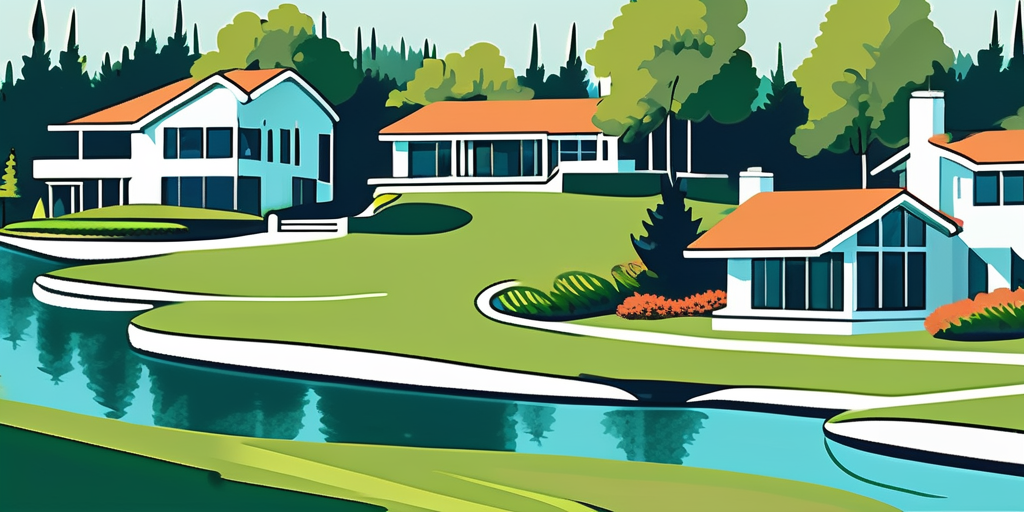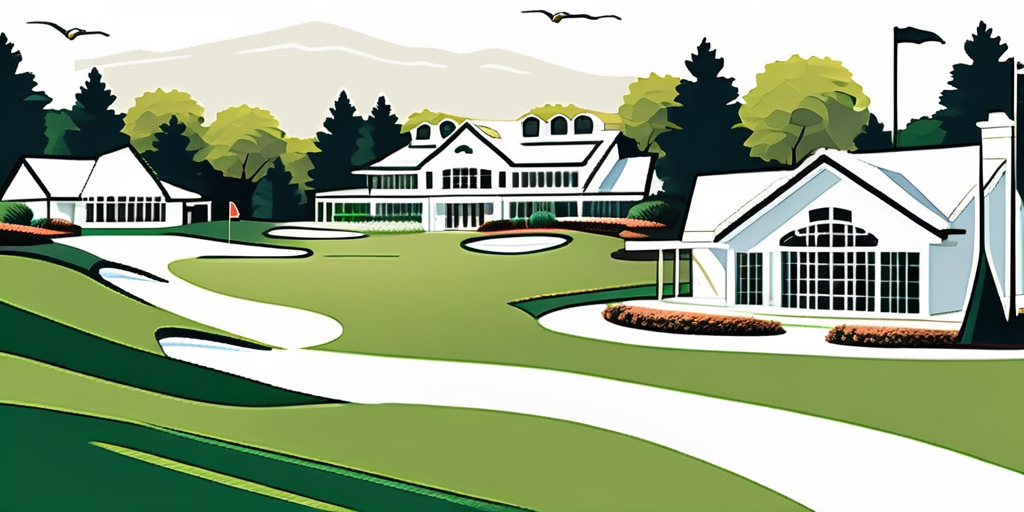
If you're considering diving into the world of real estate, particularly in the realm of golf, you've landed in an exciting niche! Golf membership real estate combines the love for the sport with attractive investment opportunities. This article will unravel the essence of golf membership properties, the current landscape, what to look out for, future predictions, and how to navigate the purchasing process.
Golf membership real estate essentially revolves around properties located within golf communities or clubs that provide golfing memberships as part of the real estate ownership. It’s not just about owning a beautiful home—it’s about being part of a lifestyle that many find appealing.

At its core, golf membership real estate includes homes, condos, or properties that come with club membership as a bonus. When you purchase these properties, you often gain access to exclusive golf courses, clubhouses, swimming pools, and other amenities. It creates an integrated living experience for golf fans or anyone looking for a sense of community.
Some communities require a one-time membership fee, while others have annual dues or monthly fees. It's essential to read the fine print; popping into a beautiful place with great golfing views might come with unexpected costs!
There’s a clear allure to golf membership properties beyond just the sport itself. Many buyers are drawn to the rich lifestyle these communities offer—think fine dining, social events, and networking opportunities in a serene, picturesque environment.
Moreover, golf communities often have beautifully maintained landscapes and amenities. It's the perfect mix of leisure and luxury! Plus, for those looking to invest, these properties often appreciate well over time, making them a wise financial move.
In addition to the golf courses, many of these communities feature other recreational facilities such as tennis courts, fitness centers, and walking trails, appealing to a wide range of interests. Families can enjoy a range of activities together, from swimming in the community pool to participating in seasonal events like barbecues and holiday celebrations. This vibrant social scene fosters connections among residents, turning neighbors into friends and creating a true sense of belonging.
Furthermore, the exclusivity of golf membership real estate can be a significant draw for potential buyers. Living in a golf community often means being part of a select group that shares similar interests and values. This exclusivity can enhance the overall experience, as residents enjoy the benefits of a well-curated lifestyle that combines leisure, luxury, and camaraderie. For many, it’s not just about the game of golf; it’s about embracing a way of life that prioritizes wellness, relaxation, and community engagement.
The landscape of golf membership real estate has evolved, particularly in the last decade. With a surge in interest from millennials and retirees seeking quality lifestyle experiences, this sector is more vibrant than ever.
Currently, the market is experiencing a unique revival. After a few years of stagnation in some areas, properties nestled within golf communities are seeing increased demand. The real estate market faced headwinds during economic downturns, but the luxury segment is rebounding and growing.
This uptick is driven by a combination of factors such as a growing interest in outdoor recreational activities and the need for lifestyle advancements. Many buyers are prioritizing quality of life over traditional investment returns, and golf properties fit that bill perfectly.
Additionally, the COVID-19 pandemic has further accelerated this trend, as many individuals and families have reassessed their living situations. The desire for spacious homes with access to outdoor amenities has led to a spike in interest for properties that offer golf courses as part of their community. As people seek to escape urban congestion, golf communities are increasingly seen as ideal havens that combine luxury living with a healthy, active lifestyle.
Various developers and real estate firms specialize in golf membership properties, ranging from niche boutique firms to big-time developers. Some well-known communities include The Villages in Florida and Desert Mountain in Arizona, to name a couple.
These players are instrumental in shaping the market trends and providing diverse investment options. Their initiatives often bring innovative amenities, outstanding architectural designs, and environmentally friendly developments that cater to both residents and golf lovers.
Moreover, many of these communities are not just about golf; they are increasingly incorporating wellness centers, fine dining options, and social clubs that enhance the overall living experience. The integration of technology in these developments, such as smart home features and virtual reality golf simulators, is also becoming more common, appealing to a tech-savvy demographic. As a result, the golf membership real estate market is not only about the sport itself but is evolving into a holistic lifestyle choice that attracts a wider range of potential buyers.
Once you've decided to explore golf membership properties, the next step is to conduct a thorough evaluation. There’s a lot to consider to ensure you make the right investment.
Several key factors should guide your decisions:
No investment comes without risks, and golf membership properties are no different. While they can provide solid returns, ensure you’re also aware of potential pitfalls.
Like any real estate venture, the value of golf properties can fluctuate based on market conditions, location desirability, and demand for golf memberships. Additionally, annual fees can increase, and if a course doesn’t maintain its appeal, it could affect property values.
However, the rewards can be significant. Many buyers enjoy a lavish lifestyle while gaining substantial equity in these properties. Consider it as both a home and a hobby—what's not to love?
Moreover, the social aspect of golf membership properties cannot be understated. Living in a golf community often means access to a network of like-minded individuals who share similar interests. This can lead to lasting friendships and a vibrant social life, with events and gatherings that foster a sense of belonging. Many communities host tournaments, charity events, and social mixers, providing ample opportunity to engage with neighbors and make new connections.
Additionally, the lifestyle benefits extend beyond just golf. Many of these communities offer a range of recreational activities, from tennis and swimming to hiking and biking trails. This variety can cater to diverse interests and ensure that there’s always something to do, making it an attractive option for families and retirees alike. The combination of leisure and luxury creates an environment where residents can thrive both socially and physically, enhancing the overall appeal of golf membership properties.
As we glance into the future, the golf membership real estate market is poised for exciting changes driven by shifting demographics and lifestyle preferences.

One notable emerging trend is the increase in multi-generational living. Families are looking for properties where various generations can live together while enjoying the shared interests that golf can foster. This trend not only enhances family bonding but also allows for shared responsibilities, making it easier to maintain a household. Golf communities that cater to this demographic often feature spacious homes with flexible layouts, as well as communal areas designed for family gatherings, ensuring that everyone from grandparents to grandchildren can find their niche.
Additionally, environmentally conscious developments are on the rise. Many golf course communities are implementing sustainable practices, making them appealing to environmentally aware buyers. These practices include the use of native landscaping to reduce water consumption, solar panels to harness renewable energy, and eco-friendly materials in construction. Such initiatives not only help preserve the natural beauty of the golf courses but also resonate with buyers who prioritize sustainability in their lifestyle choices.
Experts predict enduring interest in golf communities, especially as more people seek out lifestyle-based living options. With the growing popularity of golf among younger generations, there’s a robust pipeline for future memberships. This demographic shift is further fueled by the rise of social media, where golf is often showcased as a chic and leisurely pursuit, attracting millennials and Gen Z who are eager to engage in activities that promote health and wellness.
It’s also expected that innovation, especially in terms of technology and amenities, will enhance the attractiveness of these properties. Think smart homes integrated with golf club booking systems, or even virtual reality experiences! These advancements could provide residents with real-time updates on course conditions, personalized coaching through augmented reality, and seamless integration of fitness tracking with golf performance metrics. As technology continues to evolve, golf communities will likely become hubs of modern living, blending leisure and lifestyle with cutting-edge amenities that cater to the needs of both avid golfers and casual players alike.
Ready to take the plunge? Here’s how to navigate the purchase of golf membership real estate seamlessly.

Finally, legal considerations are paramount. Ensure you understand all necessary legal requirements related to membership transfers, property taxes, and any restrictions imposed by the community or club.
Consulting with a real estate attorney familiar with golf community laws can save you from future headaches. It’s better to be informed than to jump in blind!
Additionally, it's essential to familiarize yourself with the specific bylaws and regulations of the golf community you are considering. Each community may have unique rules regarding property use, maintenance obligations, and even the types of renovations you can undertake. Understanding these nuances can significantly impact your enjoyment of the property and your long-term investment. Moreover, inquire about the community's financial health, including the status of its reserves and any upcoming assessments that could affect your budget.
As you embark on this journey, consider the social aspects of golf membership real estate as well. Many communities offer a vibrant lifestyle with numerous social events, clubs, and activities that can enhance your experience. Engaging with fellow members can lead to lasting friendships and a sense of belonging, making your investment not just about property, but about becoming part of a community. This lifestyle aspect is often as important as the real estate itself, so be sure to explore the social calendar and amenities offered by the clubs you are interested in.